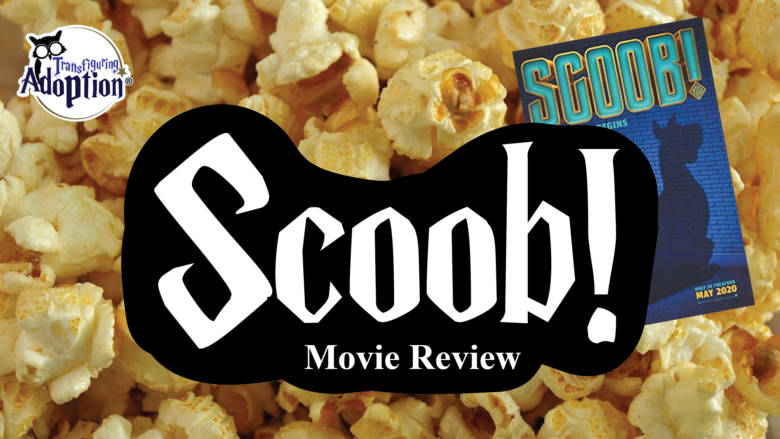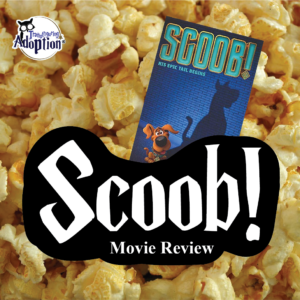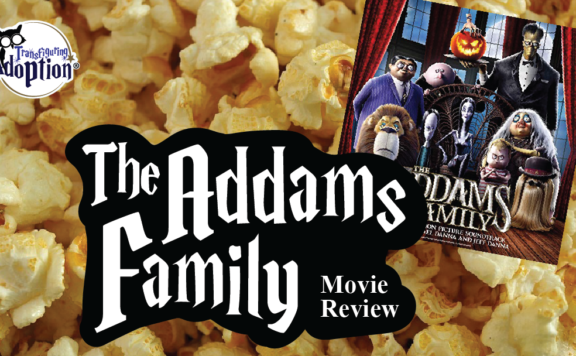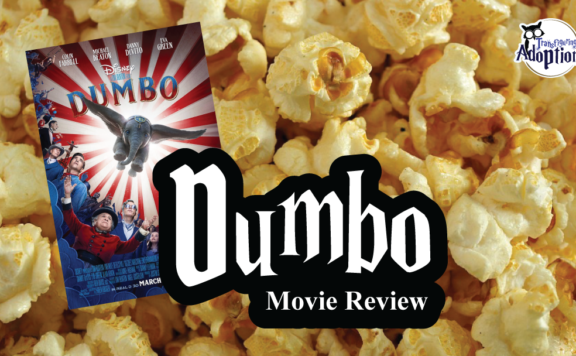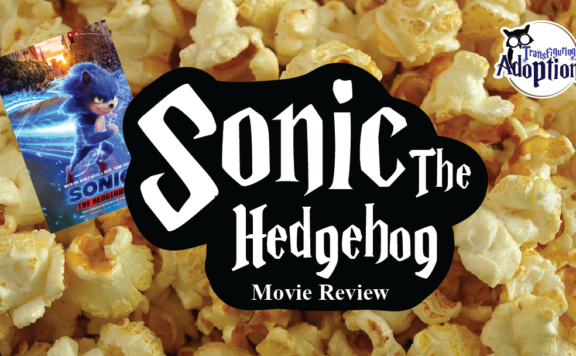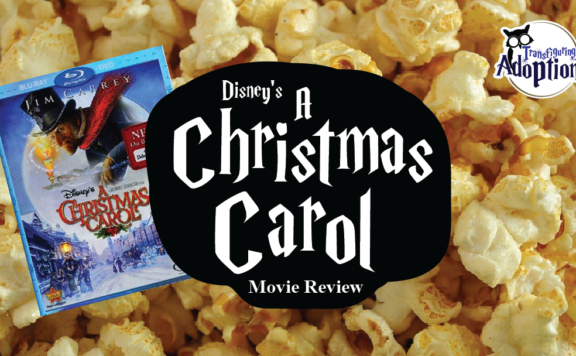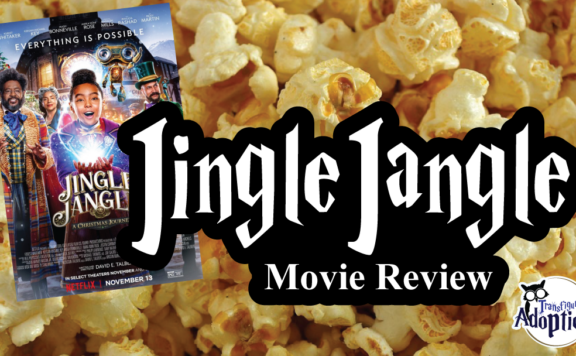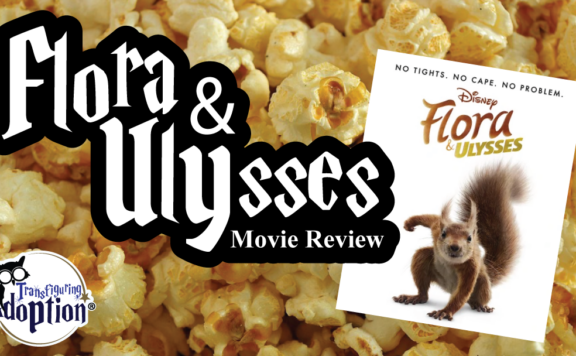Grade:
![]()
Transfiguring Adoption awarded this movie 4 Hoots out of 5 based on how useful it will be for a foster/adoptive family. [Learn more about our Hoot grading system here]
Movie Info:
-
Rating: PG
-
Genre: Action & Adventure, Animation, Comedy
-
Runtime: 94 Minutes
-
Studio: Warner Bros. Pictures
From the Cover of Scoob! by Warner Bros. Pictures:
“SCOOB!” reveals how lifelong friends Scooby and Shaggy first met and how they joined with young detectives Fred, Velma and Daphne to form the famous Mystery Inc. Now, with hundreds of cases solved and adventures shared, Scooby and the gang face their biggest, most challenging mystery ever: a plot to unleash the ghost dog Cerberus upon the world. As they race to stop this global “dogpocalypse,” the gang discovers that Scooby has a secret legacy and an epic destiny greater than anyone imagined.”
Transfiguring Adoption’s Overview:
A new generation of movie viewers are getting their chance to experience a movie starring the famous dog created by Hanna-Barbera. The movie, “Scoob!,” seemingly appeals to several different age groups due to the fact that many caregivers grew up watching the television cartoon and with several cartoon movies or live action movies even teens or young 20 somethings have been exposed to this series. The film was created for general audiences and doesn’t specifically attack issues specific only to children from traumatic backgrounds. However the movie has some great topics for families to discuss with their children to help them to be more successful as they grow into adults.
The movie was done in 3-D animation and exhibits the zany and quirky jokes that people will come to associate with the old Hanna-Barbera cartoons. Even the beginning credit sequence is taken directly from the original Scooby-Doo cartoons.
This movie focuses on the characters, Scooby Doo, Shaggy, Velma, Daphne, and Fred as they journey together through life as friends. The plot finds, Shaggy and Scooby in peril as they join the superhero, Blue Falcon, and his team to stop the supervillain Dick Dastardly. Through the course of the film Shaggy and Scooby learn about friendship as they grow as people. Velma, Fred, and Daphne realize the value and meaning of friendships despite labels people may place on others. The superhero, Blue Falcon, learns the importance of not comparing himself to others and the value of his own unique personality and talents.
** Spoilers Could Be Ahead **
How Is This Relevant To Adoption & Foster Care?
Scoob! (2020) does not directly relate to Foster Care or Adoption as the main characters are all friends. Children from traumatic backgrounds often have difficulties making friends or forming HEALTHY friendships. As was mentioned above, this movie focuses largely on the topic of friendship from several nuances which we will explore more in depth from the “Discussion Points,” and “Cautionary Point,” listed below. However, it is safe to say that any form of media could be utilized to help talk to our children from traumatic backgrounds about forming healthy relationships is worth experiencing so that your family can have a good conversation friendships.
Discussion Points:
- Imaginary Friends
The theme of friendship is strong in this movie. From the very beginning of the movie we see one of the main characters, Shaggy, struggling with being lonely and yearning for friends. He even initially makes imaginary friends out of sandhills on the beach simply to fill the void of friendship in his life. Children from traumatic backgrounds typically have not been shown how to make healthy relationships or friendships during young and formative years. Thus, a common issue we hear about from our kiddos is that they are lonely. Some children cope with this issue by creating imaginary friends. It might be worth talking with your child about imaginary friends. The process of creating imaginary friends can be fun for younger children and not necessarily discouraged. However, it would be good for families to discuss through Shaggy’s situation if the imaginary friends would have actually fulfilled his need for friends. - Friendships and Labels
During the movie the main characters of children ask an investor, Simon Cowell, to help them grow their mystery business. Cowell begins to label the young adults by the qualities he sees in them to express reasons for why he is willing to invest money in the business. Fred is labeled as athletic and strong. Velma is labeled as being a genius and super smart, while Daphne is told that she is extremely empathetic toward others which helps to win people over. Shaggy and Scooby are told that they are talentless and dead weight on the group.
Naturally, these thoughts cause a rift in the gang of friends which result in Shaggy and Scooby leaving the meeting upset. However, the rest of the group pursues Shaggy and Scooby and seeks to help their friends after they find that they are in danger.It would be good for parents to discuss with their children the qualities that make the group of kids good friends as the friendships has nothing to do with the labels. The kids can be seen as showing concern for each other, exhibiting qualities of kindness, respecting each other, looking out for each other’s safety, etc. Caregivers would do well to notice these examples in the movie and talk about them with their children to see if their children are able to find such qualities. It would then be interesting to have a conversation to see if these healthy qualities are present in your child’s current friends and talk about examples of seeing these qualities.
It would also be good to have a conversation with your children about labels. While labels can be hurtful, they can also boost someone’s self-esteem and help them to know about themselves as a person. For example at one point Fred is grateful that Velma is incredibly smart because he cannot figure out a specialized and complex situation. For him the label helps him to know that the situation is not his specialty and he doesn’t have to feel guilty about not being the one to perform the task. It would be great to discuss some positive talents of your child’s and discuss how learning/knowing about these talents make them feel. - Dealing with Change as You Grow as a Person
During a section of the movie, Scooby (the dog) was viewed as more important than best friend Shaggy (the main character and a young boy), which seemed to make Shaggy feel like he wasn’t worth much. The pinnacle of the changes can be seen as Scooby chooses to remove his dog color, which was gifted years ago by Shaggy, in order to be fitted for a superhero outfit. It can be seen in the film that Scooby didn’t choose this change in order to hurt his friend in order to engage in an opportunity to do something which he believed would make him a better person…er… dog. On both sides of this relationship the audience watches as Shaggy and Scooby have to make decisions as they deal with jealousy and guilt for hurting a friend. In the end the pair ultimately learn that they can remain friends while their interests and abilities might change and differ. While children from a foster care or adoptive background have more than likely had significant transitions, it would be good for families to discuss the transitions and changes in friendships in this movie. It will also be beneficial for parents to guide conversations about the qualities that make up a healthy friendship (such as mutual respect, a kind nature, similar core values, etc.) which normally do not change – thus, being able to talk about people possibly changing interests or changing physical location but still being able to remain as friends. - Self-Esteem or People Comparison
One of the superhero characters, Blue Falcon, struggles with feeling like he has to be exactly like his dad, who was the original superhero called the Blue Falcon. Viewers will experience the current Blue Falcon feeling like he must live up to the former fame and glory of his father’s career. Like many people, he has to accept that he can never be exactly like someone else, that he has to be his own person. Once he learns that, the character is able to embrace his own unique strengths and talents and seems to be able to get closer to his friends/team in the process.
Shaggy also has struggles with believing in himself when Scooby is deemed “more important” than he is. He begins to take it out on Scooby and tries to get his friend back to the way he was. He learns that he can always be with his friend even when they seem to be treated differently than him. - Choosing to Improve Ourselves
Scooby the dog is told at the beginning of the movie that he is “dead weight,” in his group of friends. This seems to have a profound effect on him. While working with the superhero, Blue Falcon, he mentions to the superhero, who is struggling with his talents and identity, that maybe both of them need a chance to prove themselves. This conversation between the two characters reinforces the fact that Scooby wanted to improve himself after being negatively labeled. Scooby can be seen taking on a superhero assignment which he would have not normally agreed to in order to try and improve himself. It would be interesting for families to talk about the difference between doing things to improve yourself as opposed to wishing you were someone else. Scooby could be seen wearing a new superhero outfit instead of his signature dog collar. However, through a conversation with Shaggy it is evident that he didn’t do this to hurt anyone but he simply wanted the change to improve himself.
Cautionary Points:
- Bullying
Near the beginning of the film the main characters, a boy named Shaggy and a puppy named Scooby, have their Halloween candy taken by two bullies. The bullies taunt the two characters for a short while before throwing the candy into a seemingly abandoned and scary home. This is a brief scene which sets up Shaggy and Scooby meeting the rest of their future friends as the other kids come to their aid. The good part is that the Shaggy and Scooby’s bullying is short-lived and they rapidly have other kids that befriend them. However, for children from traumatic backgrounds who have been physically or verbally abused this short event might trigger past memories. It should be noted that bullies are on skateboards and merely skate around Shaggy and Scooby so there is not an “all out fight,” and the name-calling is at a minimum. The main bullying action is the stealing of their prized candy. Parents should assess how well their child will handle a brief scene of bullying before watching this film. - Abandonment
Children who have been moved around in the foster care system or who have even been adopted may have a deep fear of being abandoned or left alone. During this movie Shaggy and Scooby are seemingly shunned by their group of friends. Later in the movie Shaggy is seemingly being left behind by his best pal, Scooby, as the dog pursues a superhero role. In both situations none of the characters are truly alone and no one was truly forgotten. However, there are similar feelings of people being thrown aside which could bother children sensitive to being left alone or abandoned. - Feelings Of Being Abnormal
Scooby was treated as more important than Shaggy, which causes Shaggy to become sad and get angry at Scooby. Children from traumatic places often are sensitive to feeling like they do not fit in with their peers or feel as though everyone else instinctively know all the negative aspects of their life story. Seeing Shaggy treated as less important than his friend may be difficult for children who feel and/or who HAVE been treated in non-important manner. We don’t feel that all children will have an issue with this trigger. It is imperative that you be in tune with your child to know if this is an issue. While this is an issue that most children will not give a second thought to during the film, those who have are sensitive to feeling subpar may be triggered.
About the Author: Jasmine Fink
Jasmine Fink is a high school student. She was adopted out of foster care when she was very young and currently lives with her family in Orlando, Florida. She is 16 years old and loves to write poems and sing. She loves to go to the parks with her family and spend time with her family.
About the Overseeing Author: Darren Fink
Co-founder and Program Director of Transfiguring Adoption. Darren is a graduate of Illinois State University where he studied fine art. He offers foster and adoptive parents over a decade of experience in parenting foster and adoptive children, as well as his introductory to counseling training. Darren enjoys visiting amusement parks with his family.
**Transfiguring Adoption is a nonprofit organization seeking to nurture growth in foster and adoptive families by giving a HOOT about their families. Transfiguring Adoption does not intend for its reviewers nor its review to be professional, medical or legal advice. These reviews and discussion guides are intended to help parents to better be able to connect and understand their children who come from traumatic backgrounds.
